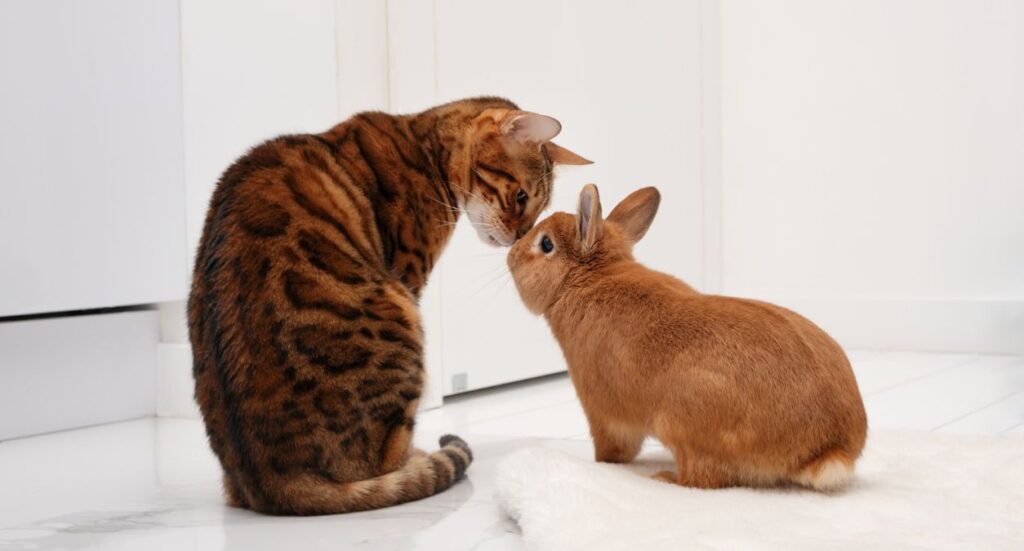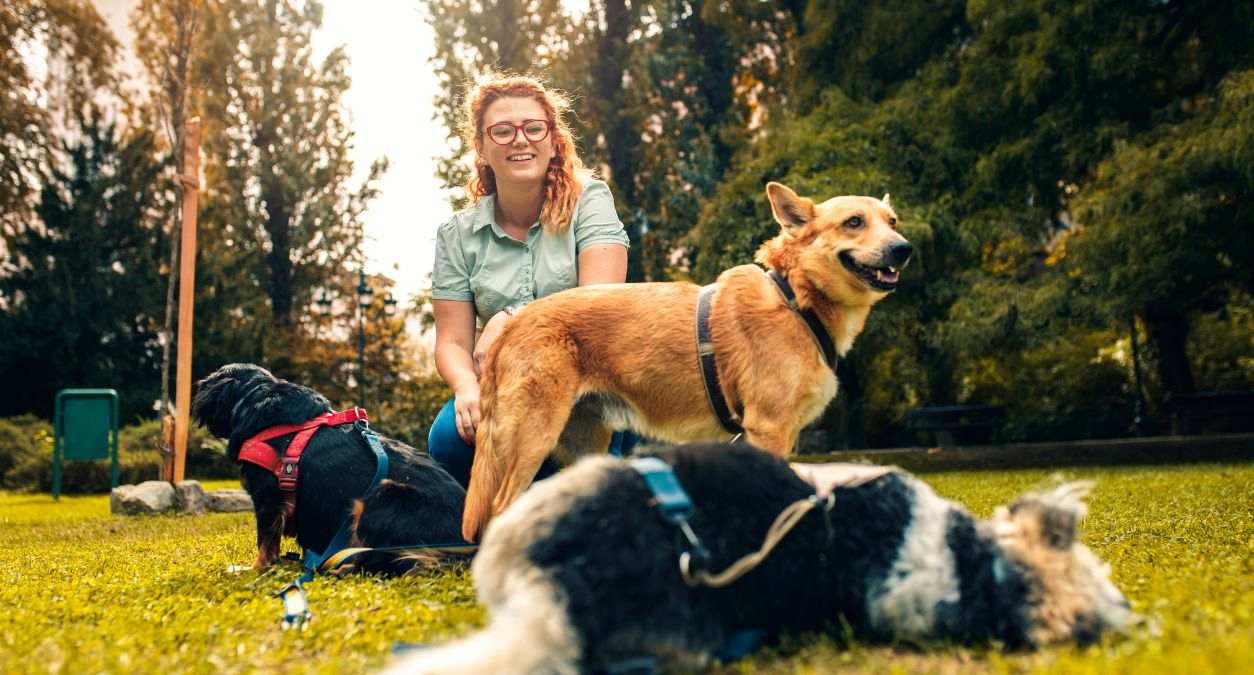Table of contents
Table of contents
Whether you’re running a doggy daycare, grooming service, or a pet sitting business, one of the most valuable skills you can develop is the ability to understand how pets think, feel, and behave. For pet care professionals, behavioural awareness is more than a nice-to-have skill – it’s a safety tool, a customer service enhancer, and a way to ensure the wellbeing of every animal in your care.
In this guide, we’ll explore the essentials of understanding dog behaviour, understanding pet behaviour more broadly, and why this knowledge is crucial for pet care providers.
Why pet behaviour knowledge matters

Understanding animal behaviour is essential for anyone working in pet care. It helps you prevent problems like aggression or escape attempts by spotting warning signs early. This makes your environment safer for pets, staff, and yourself.
It also allows you to manage stress in animals who may feel anxious in new surroundings. A calm, observant approach helps pets feel more secure, which improves their overall experience.
Beyond that, behavioural knowledge helps you explain what pets are feeling to their owners. This builds trust, shows professionalism, and strengthens client relationships. When you recognise and respond to a pet’s emotional needs, you create a safer, more supportive environment – and that’s great for business.
Understanding pet psychology: core concepts
1. Instinct vs. Learned Behaviour
- Instinctual: Hardwired behaviours like growling, sniffing, or herding.
- Learned: Actions shaped by past experiences, training, or reinforcement (like sitting on command or barking for attention).
You need to recognise which behaviours you can work with – and which you need to respect.
2. Animals speak through body language
Pets often communicate silently:
- A wagging tail isn’t always happy – it can mean uncertainty.
- Ears back, lip licking, or yawning in dogs often mean stress.
- Cats show discomfort through tail flicking, dilated pupils, and freezing.
3. Emotion is a spectrum
Pets don’t just feel “good” or “bad.” They live on a spectrum of fear, frustration, excitement, and calm. Triggers like noise, unfamiliar animals, or handling can push them to the edge quickly.
Understanding dog behaviour in pet care settings

Dogs are the most common clients in the pet industry. Their behaviour varies widely depending on age, breed, health, socialisation, and environment.
Signs of stress and anxiety
Keep an eye out for:
- Panting and pacing
- Lip licking or yawning
- Tucked tail or cowering posture
- Avoiding eye contact
- Shaking off (as if wet)
How to help:
- Stay calm and patient
- Don’t force contact
- Offer space or a quiet corner
- Use soft tones and slow movements
Understanding canine aggression
Aggression is communication, often fear-based, and comes in different forms:
- Fear-based – Defensive, not “bad behaviour.”
- Territorial – Often seen during drop-offs or pick-ups.
- Resource guarding – Around food, toys, or a person.
- Redirected – Arousal leads to lashing out at the wrong target.
Do this:
- Watch for warning signs: growling, stiffening, lip curling
- Don’t punish growling – it’s a helpful warning
- Create space between animals, especially during introductions
Social and positive behaviour
Well-adjusted dogs may:
- Offer a relaxed body and soft eye contact
- Approach calmly with a wagging tail and loose hips
- Use play bows or gentle mouthing during play
Reward this behaviour with gentle praise, treats, or petting – but only if they’re receptive.
Understanding other pets: cats and small mammals

While dogs may be the most common clients in pet care, many providers also care for cats, rabbits, guinea pigs, and other small animals. These species have distinct behavioural patterns and stress responses that every pet professional should recognise.
| Animal | Warning signs | Comfort tips |
| Cats | – Flattened ears – Dilated pupils – Tucked or lashing tail – Growling, hissing, freezing
| – Provide hiding spaces (e.g., towel-covered crates) – Avoid direct eye contact or forced interaction – Handle gently and only when necessary |
| Rabbits & Small Mammals | – Thumping or hiding – Overgrooming or teeth grinding (can indicate pain) – Refusing food or water – Kicking when restrained
| – Handle close to the ground – Use soft bedding and familiar scents – Keep the environment quiet and limit handling |
Understanding these signs and responses helps reduce stress and improve the experience for these more delicate or easily frightened pets. Creating a low-stimulation, pet-sensitive environment goes a long way in supporting their wellbeing – and their owners will notice the difference.
Top behavioural issues you might encounter
1. Separation anxiety
Very common in dogs, especially during drop-offs.
Signs:
- Barking, howling, destructive behaviour
- Pacing, panting, or refusing food
Solutions:
- Use calming music or diffusers
- Offer distraction toys or chew items
- Keep drop-off routines brief and calm
- Alert the owner – they may need a behaviourist
2. Reactivity
Dogs that lunge, bark, or snap at people or other dogs.
What causes it?
- Fear, past trauma, or lack of socialisation
What to do:
- Avoid triggers when possible
- Use leash barriers or visual dividers
- Never punish reactive dogs – refer to a positive trainer if needed
3. Excessive barking
This could mean:
- Boredom or under-stimulation
- Anxiety or alert behaviour
- Attention-seeking
Manage it by:
- Offering enrichment (snuffle mats, food puzzles)
- Rewarding calm behaviour
- Ensuring exercise and play are part of the daily schedule
Environment: shaping behaviour through space and routine
A pet’s environment plays a powerful role in shaping how they feel and behave. The sounds, smells, lighting, and daily rhythm of your space can either ease an animal’s anxiety or add to it. For instance, loud noises such as barking, shouting, or harsh music can quickly elevate stress levels, so it’s best to keep the space as quiet and calm as possible. Similarly, soft or natural lighting is less overwhelming than harsh fluorescent lights, which can agitate sensitive animals.
Scent also matters – strong or unfamiliar smells can be unsettling, so it’s important to use gentle, pet-safe cleaning products that don’t overwhelm their heightened senses. Equally important is maintaining a consistent routine. Animals feel more secure when feeding, walking, play, and rest times happen at predictable intervals.
To further reduce anxiety in high-stress settings, consider using tools like white noise machines or pheromone diffusers. These small environmental adjustments can make a significant difference in how relaxed and well-behaved pets are during their time in your care.
5 tips for better behaviour management in pet care
- Observe before interacting
Watch body language and assess the pet’s comfort before touch. - Approach on their terms
Avoid looming over pets. Crouch sideways and let them come to you. - Use positive reinforcement
Always reward desired behaviour with treats, praise, or affection. - Avoid punishment
It increases fear and reduces trust – especially for already nervous animals. - Know your limits
Refer difficult cases to professional trainers or vets when needed.
Behaviour tools & products that help
Understanding pet psychology is vital, but having the right tools on hand can make it easier to support anxious or reactive pets. From sensory aids to enrichment toys, these products can reduce stress and promote better behaviour in your care environment.
1. Calming aids
- Pheromone diffusers or sprays (e.g., Adaptil for dogs, Feliway for cats): Mimic natural calming scents that help pets feel safe.
- Calming collars: Slow-release pheromone collars are a low-maintenance option for long-term care.
- Calming treats: Some chews include ingredients like chamomile or L-theanine to help reduce mild anxiety.
2. Environmental tools
- White noise machines: Help mask sudden sounds (like barking or doorbells) that may startle sensitive animals.
- Soft, enclosed spaces: Covered beds or crates provide a safe haven for overstimulated pets.
- Pet-safe cleaning products: Strong chemical smells can trigger unease, opt for unscented or mild, pet-friendly solutions.
3. Enrichment toys
- Snuffle mats and puzzle feeders: Mentally stimulating and great for reducing boredom barking or anxiety pacing.
- Lick mats: Help soothe dogs or cats through repetitive, calming licking behaviour.
- Chew toys and frozen treats: Offer a healthy outlet for stress and can distract pets during transitions.
4. Handling accessories
- Muzzles (when used appropriately): Prevent bites during necessary care without punishing the pet.
- Slip leads and secure harnesses: Improve safety when dealing with unpredictable or reactive dogs.
- Towels and blankets: Useful for gentle restraint or creating a comforting, familiar scent barrier.
These tools don’t replace behavioural knowledge – but when used alongside it, they can transform how pets experience your services.
Behaviour red flags: When to refer to a specialist
Even the most experienced pet care providers have limits. Knowing when to refer a pet to a behaviourist or veterinary professional protects your team, your business, and most importantly, the animal’s wellbeing.
Here are some red flags that indicate it’s time to seek expert help:
1. Escalating aggression
- Frequent growling, snapping, lunging, or biting, even after calm handling
- Aggression that occurs unpredictably or in low-stress situations
- Multiple incidents with different people or pets
2. Chronic stress or shutdown
- Prolonged hiding, freezing, or refusal to eat or engage
- Repeated escape attempts or destructive behaviour
- Overgrooming, compulsive licking, or stress-related illness (e.g., digestive issues)
3. Severe anxiety or phobias
- Panic during drop-offs or storms that leads to injury or property damage
- Extreme reactivity to certain triggers (e.g., other dogs, grooming tools, car rides)
- Inability to calm down after stress – even in quiet, familiar environments
4. Medical or trauma-linked behaviour
- Sudden behaviour changes (e.g., a friendly dog becoming snappy)
- Signs of pain-related aggression, such as growling when touched
- Pets with known abuse or neglect backgrounds that need desensitisation therapy
In these cases, it’s best to refer to a certified animal behaviourist or a veterinarian who specialises in behaviour. Doing so not only ensures the pet receives the support they need but also shows your professionalism and commitment to ethical care.
When in doubt, trust your instincts and put safety first.
Why pet behaviour training boosts your business
Understanding pet behaviour isn’t just about animal wellbeing – it’s also a smart business decision.
✅ Safer work environment
✅ Happier pets and fewer incidents
✅ Stronger relationships with clients
✅ More repeat customers and referrals
✅ Opportunities for professional growth
You’re not just a service provider – you become a trusted member of a pet’s extended family.
Helpful resources for further learning
- Online learning platforms like Udemy, Coursera, or the Pet Professional Guild
To round up
Understanding dog behaviour and pet psychology is a must-have skill for today’s pet care providers. It’s what allows you to tailor your services, prevent problems before they arise, and build real trust with animals and their owners.
By paying close attention to behavioural cues and emotional needs, you’ll ensure pets feel safe, respected, and happy in your care – and that’s the best business model of all.
Get Pet Business Insurance from Protectivity
*Disclaimer – This blog has been created as general information and should not be taken as advice. Make sure you have the correct level of insurance for your requirements and always review policy documentation. Information is factually accurate at the time of publishing but may have become out of date.
Last updated by
















